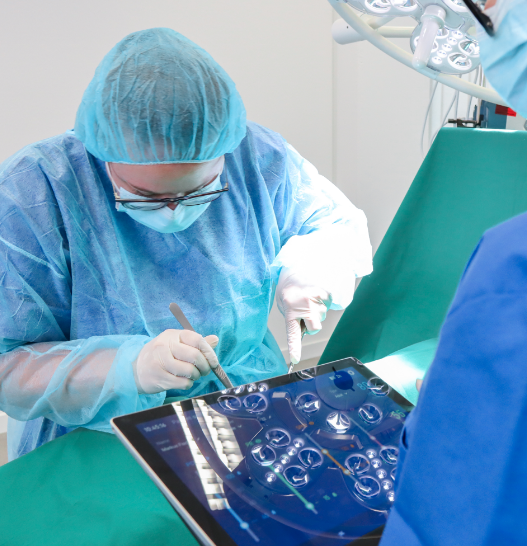What exactly is IEC 62366-1? We want to get to the bottom of this question in this article. We will explain to you quickly and in an easy-to-understand manner what there is to know about the standard. When you have read this article, you will know the answers to the following questions:
- What is IEC 62366-1?
- Who is IEC 62366-1 relevant for?
- What are the contents?
- Which version is the most recent?
- What is the relationship between IEC 62366-2 and IEC 62366-1?
Soon you will also find an article on the question “What is IEC 62366-2?” here.
What is IEC 62366-1?
IEC 62366-1 is an international standard developed and published by the International Electrotechnical Commission (IEC). This standard is a part of the two-part standard IEC 62366, which relates to the application of usability engineering to medical devices.
The German title is: Medizinprodukte – Teil 1: Anwendung der Gebrauchstauglichkeit auf Medizinprodukte. In English, the standard is called: Medical devices – Part 1: Application of usability engineering to medical devices.
IEC 62366-1 focuses specifically on the usability engineering process required to analyze, specify, develop and evaluate the usability of medical devices. It describes how medical device manufacturers can perform usability engineering throughout the product life cycle, including planning, design, development, documentation, manufacturing, distribution, and aftercare.
The goal of this standard is to ensure that medical devices are designed to be as usable as possible for their intended function and to minimize the risk of errors or accidents due to usability issues.
For whom is IEC 62366-1 relevant?
IEC 62366-1 is relevant to all organizations and individuals involved in the design, manufacture, testing, certification and regulation of medical devices. We designate the following:
- Medical Device Manufacturers: These companies must comply with the requirements in Annex I of the MDR. Part of this is requirements for the operation and safety of the devices. To this end, the standard presents a process that simplifies this demonstration.
- Testing and certification bodies: These organizations must verify compliance with the requirements of the MDR.
- Regulatory agencies: Agencies such as the U.S. Food and Drug Administration (FDA) use such standards to better and more efficiently evaluate the safety and effectiveness of medical devices.
- Usability and usability experts: These professionals can be directly involved in the application of the standard to design and evaluate medical devices.
What is the content?
As mentioned above: IEC 62366-1 focuses on the application of usability engineering to medical devices. It describes a process for analyzing, specifying, designing, and evaluating usability that aims to control the risk to the user from usage errors.
A step-by-step flow of the usability engineering process according to IEC 62366-1 can be found in our article “Usability engineering for medical devices according to IEC 62366-1“.
Not all parts of a product have to go through the entire usability engineering process in every case. The standard defines an abbreviated process for user faces of unknown origin: the User Interface of Unknown Provenance (UOUP) process. What exactly qualifies you for this shortened process can be found in our article “When are you enabled to use the UOUP process?“. For a deeper dive on the topic, check out our “Deep Dive: User Interface of Unknown Provenance“.
IEC 62366-1 also emphasizes the need for documentation throughout the process and consideration of usability throughout the lifecycle of the medical device.
Which version is the most recent?
The most current version is IEC 62366-1:2015 + COR1:2016 + A1:2020. The original version was published in 2015, since then there has been an amendment in 2020 that made some corrections to the original standard.
The (old) IEC 62366, which was published in 2007, has thus now been completely superseded and is no longer up to date!
Which version is the most recent?
The most current version is IEC 62366-1:2015 + COR1:2016 + A1:2020. The original version was published in 2015, since then there has been an amendment in 2020 that made some corrections to the original standard.
The (old) IEC 62366, which was published in 2007, has thus now been completely superseded and is no longer up to date!
How does IEC 62366-1 compare to IEC 62366-2?
While both parts emphasize the importance of usability engineering in the design of medical devices, they have different focuses.
IEC 62366-1, as mentioned earlier, describes a process to be followed to analyze, specify, design and evaluate the usability of medical devices.
IEC 62366-2 is a Technical Report (and thus not a standard, as is IEC 62366-1) and serves as a guide to the application of IEC 62366-1, providing more detailed information and practical advice on how to meet the requirements of IEC 62366-1. For example, it provides guidance on how to conduct usability tests, identify user requirements, and design user interfaces.
In short, IEC 62366-1 specifies what needs to be done to ensure the usability of medical devices, and IEC 62366-2 provides guidance on how to put these requirements into practice.
Conclusion
Let’s summarize the main points once again:
- IEC 62366-1 is an international standard published by the International Electrotechnical Commission (IEC). It specifies requirements and guidelines for the application of usability engineering to medical devices. The main purpose of this standard is to ensure that medical devices are designed and developed to be safe and effective for their intended use.
- The standard describes the usability engineering process and the abbreviated User Interface of Unknown Provenance Version.
- IEC 62366-1 is relevant to medical device manufacturers, testing and certification bodies, regulatory authorities, and usability experts. It is a critical tool for ensuring the safety and effectiveness of medical devices.
- IEC 62366-2 is a Technical Report with the aim of providing practical assistance for the application of IEC 62366-1! Here, for example, suitable methods for the respective steps of usability engineering according to IEC 62366-1 are suggested.
How can we help you with usability engineering for your medical device? Please contact us via our contact form. We are looking forward to hearing from you.



